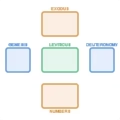The Decalogue as Key to the Woven Torah: Research Series
Discovering the Divine Paradigm
The Torah Weave project presents a revolutionary approach to understanding the structure of the Torah. This academic research series explores how the Decalogue (Ten Commandments) provides the key to unlocking the complex woven structure of the entire Torah.
“The Decalogue is not merely a list of commandments—it is the divine paradigm for understanding how the entire Torah was composed and should be read.”
This five-part scholarly series reveals how the Ten Commandments, when properly understood as a woven composition, offers us essential insights into the Torah’s two-dimensional structure—a structure that contains multiple layers of meaning beyond what a linear reading can provide.
Series Overview
| Article | Key Focus |
|---|---|
| Introduction: The Decalogue as Paradigm | How the Decalogue serves as a divine model for reading the Torah |
| Dividing the Ten Words: Finding the Pattern | Different traditions of dividing the Ten Commandments and the evidence for the five-pair arrangement |
| Five Consecutive Pairs: The Woven Structure Revealed | How the five pairs create both a hierarchical flow and a concentric symmetry |
| The Two Tablets: Individuals and Relationships | The divine dyad represented by the two tablets and their connection to the Trees of Eden |
| Conclusions: Implications for Reading the Torah | How the woven structure of the Decalogue applies to the entire Torah |
Key Insights
This research series reveals several groundbreaking insights:
1. The Woven Arrangement
The Ten Commandments were not written sequentially on the tablets but alternately, with odd-numbered commandments on one tablet and even-numbered commandments on the other. This creates five pairs of commandments that form a woven pattern.
2. Two Reading Modes
The Torah can be read in two complementary ways:
- Exoterically (linearly): As it has been read for millennia, primarily as a collection of laws
- Esoterically (multi-dimensionally): As a woven text with meaning embedded in its structure
3. The Divine Dyad
The two tablets represent a fundamental divine dyad that appears throughout the Torah:
- Tablet 1: Focuses on individuals, unity, separation, intrinsic identity
- Tablet 2: Focuses on relationships, multiplicity, connection, extrinsic attributes
4. Structural Theology
The structure of the Decalogue itself communicates theological meaning, expressed in both hierarchical flow (from divine to human) and concentric symmetry (with human life at the center).
Download the Complete Research
For scholars and serious students who wish to study this material in depth, you can download the complete research paper as a PDF.
Full Research Paper (Coming Soon)
About the Research
This research series is part of the Torah Weave project’s ongoing exploration of the Torah’s sophisticated literary structure. The approach focuses on revealing how the Torah functions as a unified, woven composition with multiple dimensions of meaning.
The analysis combines traditional Jewish and Christian interpretations with modern literary analysis to uncover patterns and structures that have remained hidden in plain sight for millennia.
Related Research
The insights from this series connect to other aspects of our Torah Weave research:
- The Creation Weave: Genesis 1 as a Multi-Dimensional Text (Coming Soon)
- The Five Concentric Rings of the Torah (Coming Soon)
- The Book Maps: Visual Guides to Torah Structure (Coming Soon)
Share your thoughts and questions about this research in the comments section below.
